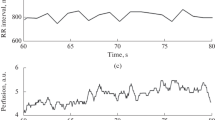Abstract—The experimentally revealed high phase coherence between low-frequency oscillations in the cutaneous blood perfusion signal at the contralateral skin sites indicates the existence of a central mechanism of its regulation. The vascular bed can be such a regulatory mechanism because it is a closed hydrodynamic system. It has been shown in this study using a mathematical model of the human cardiovascular system that the impact of low-intensity stochastic perturbations on the stiffness of the cardiac ventricles leads to the formation of low-frequency oscillations in microvascular blood flow. The results show that there is a relationship between the activity of the heart and low-frequency oscillations of microcirculatory skin blood flow, which is due to the hydrodynamic properties of the vascular bed without the involvement of autonomous control from autonomic nervous system.





Similar content being viewed by others
REFERENCES
U. Hoffmann, A. Yanar, U. K. Franzeck, et al., Microvasc. Res. 40 (3), 293 (1990).
A. Stefanovska, M. Bracic, and H. D. Kvernmo, IEEE Trans. Biomed. Eng. 46 (10), 1230 (1999).
M. E. Mück-Weymann, H.-P. Albrecht, D. Hager, et al., Microvasc. Res. 52 (1), 69 (1996).
S. Bertuglia, A. Colantuoni, and M. Intaglietta, Microvasc. Res. 48 (1), 68 (1994).
S.A. Landsverk, P. Kvandal, T. Kjelstrup, et al., Anesthesiology 105 (3), 478 (2006).
P. Kvandal, S. A. Landsverk, A. Bernjak, et al., Microvasc. Res. 72 (3), 120 (2006).
A. Bernjak, P. B. M. Clarkson, P. V. E. McClintock, et al., Microvasc. Res. 76 (3), 224 (2008).
J. M. Stewart, I. Taneja, M. S. Goligorsky, et al., Microcirculation 14 (3), 169 (2007).
A. V. Tankanag, A. A. Grinevich, T. V. Kirilina, et al., Microvasc. Res. 95, 53 (2014).
A. V. Tankanag, A. A. Grinevich, I. V. Tikhonova, et al., Biophysics 62 (4), 629 (2017).
A. A. Grinevich, A. V. Tankanag, V. G. Safronova, et al., Doklady Biol. Sci. 468, 106 (2016).
A. A. Grinevich, A. V. Tankanag, and N. K. Chemeris, Math. Biol. Bioinform. 11, 233 (2016).
A. A. Grinevich, A. V. Tankanag, and N. K. Chemeris, in Proc. SPIE, Saratov Fall Meet. 2016: Laser Physics and Photonics XVII and Computational Biophysics and Analysis of Biomedical Data III, 10337, 103371A (2017).
M. Ursino, Am. J. Physiol. 275, H1733 (1998).
S. G. Shroff, J. S. Janicki, and K. T. Weber, Am. J. Physiol. 249, H358 (1985).
A. V. Tankanag and N. K. Chemeris, Phys. Med. Biol. 53, 5967 (2008)
G. V. Krasnikov, M. Y. Tyurina, A. V. Tankanag, et al., Respir. Physiol. Neurobiol. 185 (3), 562 (2013).
V. Ticcinelli, T. Stankovski, D. Iatsenko, et al., Frontiers Physiol. 8, 749 (2017).
http://meduniver.com/Medical/Physiology/357.html (cited October 30, 2018).
http://www.amedgrup.ru/davlen.html (cited October 30, 2018).
http://www.km.ru/zdorove/encyclopedia/pokazateli-deyatelnosti-serdtsa (cited October 30, 2018).
http://medbiol.ru/medbiol/anatomia/000007e7.htm (cited October 30, 2018).
Funding
This work was supported by the Russian Science Foundation, project no. 16-15-00248.
Author information
Authors and Affiliations
Corresponding author
Ethics declarations
Conflict of interests. The authors declare that they have no conflict of interest.
Statement of compliance with standards of research involving humans as subjects. All procedures performed in studies involving human participants were in accordance with the ethical standards of the institutional and/or national research committee and with the 1964 Helsinki Declaration and its later amendments or comparable ethical standards. Informed consent was obtained from all individual participants involved in the study.
Additional information
Translated by E. Puchkov
Abbreviations: CVS, cardiovascular system; MCB, microcirculatory bed; UVR, united vascular reservoir; EHR, efficient hydrodynamic resistance; WNLFB, white noise with limited frequency band.
Rights and permissions
About this article
Cite this article
Grinevich, A.A., Tankanag, A.V. & Chemeris, N.K. The Impact of Stochastic Perturbations upon the Hydrodynamic Relationship between the Activity of Human Cardiac Ventricles and Low-Frequency Blood Flow Oscillations in the Microcirculatory Bed. BIOPHYSICS 64, 117–128 (2019). https://doi.org/10.1134/S000635091901007X
Received:
Revised:
Accepted:
Published:
Issue Date:
DOI: https://doi.org/10.1134/S000635091901007X




